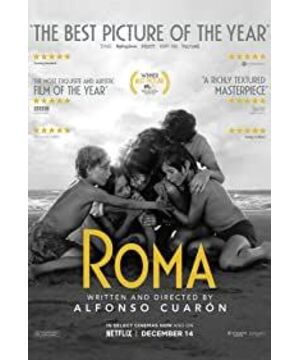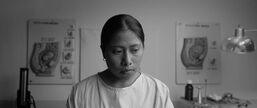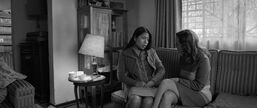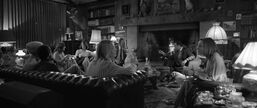"Rome"
The director pointed out that this is an autobiographical film, and 90% of the scenes in it are from his childhood memories. From the perspective of the maid Xiaoke, the film constructs two intertextual female images - the maid Xiaoke was abandoned by her boyfriend Fermin, and the mistress Sofia was abandoned by her husband Antonio.
The timeline of Xiao Ke and Sophia being abandoned is basically the same. Xiao Ke told Fermin that he was pregnant, and Fermin escaped under the guise of going to the toilet; Antonio told Sofia to go to Canada on a business trip, which was actually an abandonment of the family; Xiao Ke saw Antonio and his lover on the street, so he went to Fermin, Say goodbye to Fermin. Sophia was not used to driving big cars, so she bought a small car that was adapted to the passage at home to say goodbye to her husband.
Regarding the change in the relationship between Cleo and Sofia, at the beginning, the two had a simple master-slave relationship. When Antonio came home, the master's family watched TV happily, and Xiao Ke also squatted down and snuggled beside the child. At this time, Sophia asked Xiao Ke to bring her husband a cup of tea, indicating that in Sophia's heart, Xiao Ke was just a servant. And Xiaoke didn't stop the child from eavesdropping on Sophia's phone in time, and her husband stepped on dog shit, which made Sophia lose control of her emotions and let Xiaoke hold her breath. Their relationship changed after Xiao Ke told Sophia that she was pregnant unexpectedly. The common psychology and situation of the two women made Sofia willing to understand Xiaoke. At the climax of the film, Sofia invited Xiaoke to go out to sea together. Everyone sat at a table for a family meeting. Xiaoke, the children and Sofia experienced After the drowning, the hugs of everyone in the same boat truly realized Xiao Ke's integration into the family.
There are several details on the narrative level that are worth savoring. First, the husband's ring. When the husband first came home with his family, he had the ring in his hand. Later, the husband never returned home. Xiao Ke found the ring removed by her husband in the drawer, indicating that her husband had decided to leave. Second, the metaphor of garage and car in the film. The first time the husband returns home in the film, in order to park the car, he unhurriedly fell three times in a row, in contrast to the long time his wife and children waited in front of the house; the second time, Sofia took Xiao Ke to the hospital and got stuck between two cars on the way, which indicated that Xiao Ke and Sofia were both faced with a dilemma; for the third time, Sofia accepted the reality of her husband's derailment and went home drunk. Rampage while parking, not at all as careful as her husband with obsessive-compulsive disorder; for the fourth time, after Xiao Ke had a miscarriage, Sophia came back in a new car that was more suitable for the passage at home, which meant that there would never be a car accident again. stuck situation. This is also a symbol of Sophia giving up the adjustment of her old married life and bravely choosing to go on independently.
The director's narrative is neat and tidy, without spending a fortune. About the love experience of Xiao Ke and Fermin, six scenes were used to describe it. In the first scene, in the restaurant, Xiao Ke meets Fermin. In the second scene, Xiao Ke and Ferming watched a movie, and the two took the opportunity to act alone. In the third scene, Fermin performed martial arts, and Xiao Ke looked at him admiringly. The two have a relationship. In the fourth scene, in the cinema, Xiao Ke told Fermin about her pregnancy, and Fermin escaped with urine. In the fifth game, Xiao Ke came to the square to find Fermin, and the relationship between the two was broken. In the sixth scene, when Xiaoke was purchasing a stroller, Fermin pointed a gun at Xiaoke, causing Xiaoke to have a miscarriage.
The narration of the film cannot be unilaterally divided into Xiaoke's part and Sophia's part. The director believes that "From the perspective of the whole script, there is no so-called A and B lines. This is not a two-track story, but a personal experience. Nested within a grand social perspective."
Of course, talking about "Rome" is inseparable from the discussion of the social background at that time. It was 1969-1970, and Mexico had just experienced a brutal crackdown on the student movement. In addition, at that time there was a deep conflict between the elite class represented by the white team in Mexico and the peasant class represented by the indigenous Indians. In the film, the dog of the Christmas family is always killed by the locals. As revenge for the family's occupation of the land, Xiaoke's mother's land is also invaded.
"The film takes place in a time that definitely scars any individual, and we can assume that everyone suffers differently and suffers differently. However, the social practices depicted in the film undoubtedly exist in the same way as Mexico's. One of the most important and deep scars in the collective consciousness of man.” How does the director weave the social context into the narrative of the main characters? The military band that Sofia marched on the street when she sent her husband away, the martial arts training that Fermin participated in, the woman who hugged the corpse in agony when Xiao Ke had a miscarriage, and the military band that was finally suppressed by the revolution was brought back to the street.
When the script of "Roma" was not yet formed, Alfonso Cuaron had three principles in mind: 1. This story completely belongs to "Cleo" in real life, and her experience is the soul of this movie; 2. .Writing a movie with memories, every little detail of the past is crucial to the narrative; 3. The picture of "Roma" must be black and white, which is closely connected with the past in essence. It was shot with a 6k digital 65mm camera to enhance the The sharpness of the subtlety of the picture.
Regarding the film's use of black and white, Alfonso himself explained, "Of course I want the film to look like the old days, but this is not nostalgic or deliberately made the picture old, so I didn't shoot on film, I don't need those The graininess, like any other film, is a game between memory and the present, the sense of dynamic fluidity that brings people back to the flowing memory.”
From the perspective of photography, Alfonso chose a risky move this time. Because he was worried that the photographer could not understand the Mexican language and affect the expression of the lens, he completed the shooting by himself. "But this kind of change is actually beneficial, because after I explained things like camera positions, camera positions, and storyboards to Lubetsky before, I can give him the peace of mind and don't have to worry about it so much. In the second case, because it needs to rely heavily on the flow of personal emotions and memories, on the set, you can take into account various elements during the shooting, including actor status, lighting, etc., and going to the camera in person will make the rhythm and position of the camera move closer to the preset in your mind. The idea is very good."
Alfonso chose to use long shots to show the movement of the characters. In the first shot of the opening, the foamy water on the floor kept spreading, the camera slowly moved up, we saw the female protagonist Xiao Ke, followed by Xiao Ke lifted the bucket, put down the bucket, entered the toilet, entered the kitchen, and was on the edge of the big villa. The scheduling of characters is completed in the wide passage of . The photographer keeps a good distance from the main characters. This is a stable, safe and objective social distance, which shows the attitude of the creator. Although the book is a memory full of personal emotions, it still remains Do your best to remain calm and restrained. Judging from the images behind, no matter how much setbacks and difficulties the main characters have experienced, the director tries to maintain such an emotional attitude.
At the same time do not begrudge the use of montage. In the scene where the husband is driving home, there is a lump of shit on the ground, a barking dog, an elegant symphony in the car, dusting the ash, and the book on the co-pilot. , the pursuit of perfection, and even suggest that the husband is trying to adjust his relationship with the family.
In fact, before the infinitely close to naturalistic shooting, the behind-the-scenes team put a lot of effort into the selection of shooting locations and actor preparation, repeated auditions, and selected non-professionals to play their real-life "roles" in the film. "Another principle of mine in terms of actors' performances is that they need real life situations, and I don't tell actors what to do because they know life itself better than I do," Cuaron said. "I can't tell the film either. What questions should a 'gynecologist' ask a patient in, their life experience is more important."
Another example is, "For the scene of the picnic in the woods, I divided the actors into several groups, each group held a specific script, and they were not allowed to communicate with each other, and they would not know the content of the other groups' scripts. The scene was thrown into chaos, and the messiness of life brought about by this veil of ignorance is the real feeling of life.”
In order to bring the scenes and locations as close to the director's memories as possible, the team of art director Eugenio Caballero recreated the home from the film "Roma" in an abandoned house. "Eugenio reclaimed about 70 percent of his discarded furniture, almost relocating his new home.
Many places where the camera does not appear, like the drawers of the wardrobe, are filled with daily necessities, just for the feeling of home. ” Cuaron said. The surprising opening shot, the plane reflected in the water stains on the garage floor, was drawn by the VFX artist based on the outline of the plane at that time.
For the use of sound, the director pays great attention to ambient sound in any scene. When Xiao Ke was doing laundry on the rooftop, there were broadcasts, music, the sound of water droplets, and the sound of dogs barking; when running on the street with a maid friend for the first time, there were broadcast sounds, traffic sounds, dog barking, human voices, and the sound of two people playing. , car engine sound, car horns, footsteps, panting, it can be said that the director tried his best to restore the environment of the 1970s through sound, and auditory elements became an important auxiliary force for visual elements.
View more about Roma reviews











